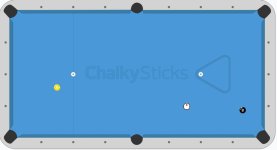Coos Cues
Coos Cues
Was in the process of a routine runout last night in league when I scratched in the side while shooting the 8 ball. I wanted to come off the side rail a bit shy of the side pocket on two rails to approach the 9 correctly instead of across the shape zone. I shot a tip of outside and I cut the 8 right down the middle of the pocket had it not scratched in the side it would have rolled right into the zone so the speed was correct My team mate who plays maybe a little better than me told me I should have used inside to avoid that rail altogether but that bring the speed margin of error way down and risks a tougher nine ball. I hate to approach the shape zone across it but not as much as I hate giving a game away like tht.
I was genuinely surprised to scratch and play mostly on my 9 foot table at home. So I set the shot up at home today and never came within a half diamond of scratching on a lot of tries.
So my question is, I know the two sizes are the same length/width relationship but is there something about the smaller table that brings that side pocket into play on shots like this that is different than a nine footer? I swear there is but can't wrap my mind around how this could be from a geometry/physics standpoint. I feel the side pocket gets me a lot more often on 7 footers than 9 shooting the same shots the same way Am I nuts?
I was genuinely surprised to scratch and play mostly on my 9 foot table at home. So I set the shot up at home today and never came within a half diamond of scratching on a lot of tries.
So my question is, I know the two sizes are the same length/width relationship but is there something about the smaller table that brings that side pocket into play on shots like this that is different than a nine footer? I swear there is but can't wrap my mind around how this could be from a geometry/physics standpoint. I feel the side pocket gets me a lot more often on 7 footers than 9 shooting the same shots the same way Am I nuts?
